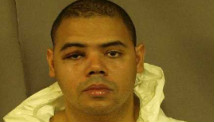The truck owned and driven by suspected cop killer Christopher Dorner during his alleged rampage through the Los Angeles area was found deserted and in flames on the side of Bear Mountain, Calif., this afternoon -- with tracks in the snow leading away from the vehicle.
The San Bernadino Sheriff's Department confirmed the truck was Dorner's, but said at a news conference this evening that the tracks around the truck did not lead to him.
Personnel from several departments and teams of dogs continued to search the area near Big Bear Lake, about 80 miles east of Los Angeles, including door-to-door searches of cabins located there, officials said.
Dorner, a former Los Angeles police officer and Navy reservist, remained on the loose.
"He could be anywhere, at this point, and that's why we're searching door to door," San Bernardino County Sheriff John McMahon said.
He added that the search would continue as long as it was possible. However, a snowstorm was forecast for the area.
Dorner was believed to have killed one police officer and injured two others early this morning in Riverside, Calif. He was also accused of killing two civilians on Sunday. And he allegedly released an angry "manifesto" airing grievances against police and warning of coming violence toward cops.
Read More About Chris Dorner's Allegations Against the LAPD
Heavily armed officers spent much of Thursday searching for signs of Dorner, investigating multiple false leads into his whereabouts and broadcasting his license plate and vehicle description across the California Highway System.
Christopher Dorner: Ex-Cop Wanted in Killing Spree Watch Video
Engaged California Couple Found Dead in Car Watch Video
Missing Ohio Mother: Manhunt for Ex-Boyfriend Watch Video
Around 12:45 p.m. PT, police responded to Bear Mountain, where two fires were reported, and set up a staging area in the parking lot of a ski resort. They did not immediately investigate the fires, but heavily armed SWAT team members eventually descended onto Bear Mountain from a helicopter manned with snipers to investigate and reached the truck.
Also today, CNN's Anderson Cooper said Dorner had sent him a package at his New York office that arrived on Feb. 1, though Cooper said he never knew about the package until today. It contained a DVD of court testimony, with a Post-It note signed by Dorner claiming, "I never lied! Here is my vindication."
It also contained a keepsake coin bearing the name of former Los Angeles Police Chief William J. Bratton that came wrapped in duct tape, Cooper said. The duct tape bore the note, "Thanks, but no thanks Will Bratton."
Bratton told Cooper on his program, "Anderson Cooper 360," that he believed he gave Dorner the coin as he was headed overseas for the Navy, Bratton's practice when officers got deployed abroad. Though a picture has surfaced of Bratton, in uniform, and Dorner, in fatigues, shaking hands, Bratton told Cooper he didn't recall Dorner or the meeting.
PHOTOS: Former LAPD Officer Suspected in Shootings
Police officers across Southern California were on the defensive today, scaling back their public exposure, no longer responding to "barking-dog calls" and donning tactical gear outdoors.
Police departments have stationed officers in tactical gear outside police departments, stopped answering low-level calls and pulled motorcycle patrols off the road in order to protect officers who might be targets of Dorner's alleged rampage.
"We've made certain modifications of our deployments, our deviations today, and I want to leave it at that, and also to our responses," said Chief Sergio Diaz of the police department in Riverside, Calif., where the officers were shot. "We are concentrating on calls for service that are of a high priority, threats to public safety, we're not going to go on barking dog calls today."
Sgt. Rudy Lopez of the Los Angeles Police Department said Dorner is "believed to be armed and extremely dangerous."
Early Thursday morning, before they believe he shot at any police officers, Dorner allegedly went to a yacht club near San Diego, where police say he attempted to steal a boat and flee to Mexico.
He aborted the attempted theft when the boat's propeller became entangled in a rope, law enforcement officials said. It was then that he is believed to have headed to Riverside, where he allegedly shot two police officers.
"He pointed a handgun at the victim [at the yacht club] and demanded the boat," said Lt. David Rohowits of the San Diego Police Department.
Police say the rifle marksman shot at four officers in two incidents overnight, hitting three of them: one in Corona, Calif., and the two in Riverside, Calif.















